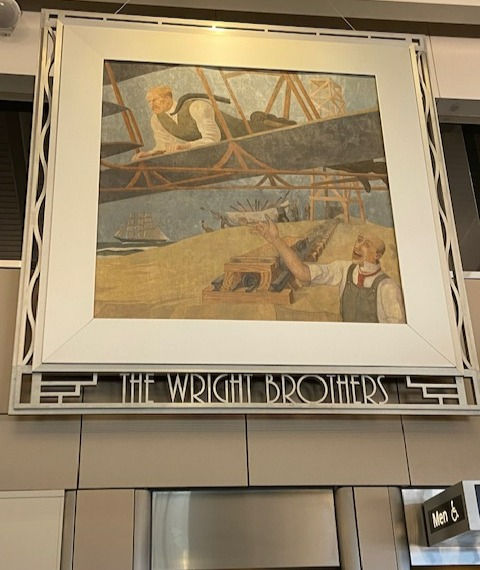Flying high while waiting around
- James Tyler
- Jun 14, 2023
- 4 min read
Updated: Jul 16, 2023
There’s something magical in the flight of a pelican. The ungainly looking bird often coasts serenely just above the surface of the water. It’s a natural ability that has long been a pelican’s heritage.
Humans aren’t as fortunate when it comes to flying. Our ability to take to the skies comes not from instinctive traits but from a long history of study, experiments, trial-and-error efforts and the understanding of scientific principles.
When I think of pelicans, I think of Florida as I’ve often marveled at their graceful flights while strolling along the beach.
When I contemplate humanity’s conquest of the skies, I now think of Florida, too. That’s thanks to a series of murals at Tampa International Airport.

Back in 1939, a St. Petersburg, Florida, artist named George Snow Hill was commissioned to paint seven murals as part of the Works Progress Administration’s Federal Arts Project.
Hill went on to create the “History of Flight” murals for the then newly built Peter O. Knight Airport, which was one of 800 airports constructed under the WPA.
In 1965 the airport was demolished, and the murals were stowed away except for two that were used in the new airport’s executive offices. Eventually all seven were painstakingly refurbished and are now on display in Airside E.
While waiting on a flight at Tampa International, I wandered along enjoying the old paintings, hanging high up on the walls in intricate, Art Deco-style frames. What could just be dull, commercial-building interior space becomes instead both an art gallery and way to learn about history, mythology and scientific progress.

Hill created these murals when machine-powered flight was less than 40 years old. Orville and Wilbur Wright made their historic first flight on Dec. 17, 1903, on the beach in Kitty Hawk, North Carolina, after years of experimenting in their bicycle shop in Dayton, Ohio.
They invented the airplane after figuring out that flight is affected by three primary factors – wing shape, power and control.
So it’s no surprise that one of Hill’s colorful murals depicts Orville Wright atop the Wright Flyer as his brother cheers him on.

The famous brothers used the research done by Otto Lilienthal, a 19th century German engineer who created 18 different gliders after studying bird flight dynamics and aerodynamics.
Lilienthal went on to make more than 2,500 glider flights. Hill depicts him high in the sky holding on to one of his gliders as an eagle soars nearby.
Back in the 1780s another pair of brothers were getting off the ground. These were Jacques Etienne Montgolfier and his brother, Joseph Michel, who invented the hot air balloon.

In 1783 they made their first public launch, rising to 6,600 feet and safely returning it to the ground. By that fall they launched a balloon that actually carried live things (not them yet): a sheep, duck and rooster.
All went well, and it’s that historic flight that Hill depicts in his mural, showing the brothers loading the livestock into their balloon.

Other murals in the Hill’s series includes “Tony Jannus in Russia,” which features the flight instructor and demonstrator. Jannus is shown making the first scheduled flight of a winged aircraft across Tampa Bay between St. Petersburg and Tampa, using an amphibious biplane.

Another mural commemorates this historic 23-minute flight, which set up regular scheduled airline service between two cities for the first time in the world.
Seems appropriate for Tampa’s airport to make a big deal of that.

Another of Hill’s murals honors Archimedes, the famed mathematician born in 287 B.C. The Greek engineer, inventor and astronomer developed the sciences of mechanics and hydrostatics among many other scientific and mathematical achievements.
In the mural, Archimedes holds up a dove while likely discussing flight principles with two other natural philosophers.
So that brings us to Hill’s seventh “History of Flight” murals – Icarus and Daedalus. This moves us from the realm of science to that of mythology.

In “Metamorphoses,” the Roman poet Ovid tells the Greek legend of the inventor Daedalus who creates wings made from feathers and wax.
The idea was that he and his son, Icarus, could escape from the labyrinth he had made to protect King Mino’s treasure but in which they were made prisoners.
Dad tells his boy not to fly too close to the sun because the sun’s heat would be a safety hazard when you’re soaring with wings held together by wax.
Long story short, Icarus is having too good a time flying and goes too high and tragedy ensues. Hill’s mural shows a nude Icarus dismayed as one of his wings comes off his back while behind him Phaethon, the son of the god Helios, sails by in the sun chariot on his daily flight across the sky.
So the mural shows the myth of man’s first flight – even though it didn’t go too well. A bit of an odd choice to see in an airplane terminal while waiting on your plane.
Overall, though, Hill’s murals are fun to view. And it makes you wonder what he might have chosen to add to the collection if he were doing them today and had another 80 years of flight achievements to pick from.



Comments